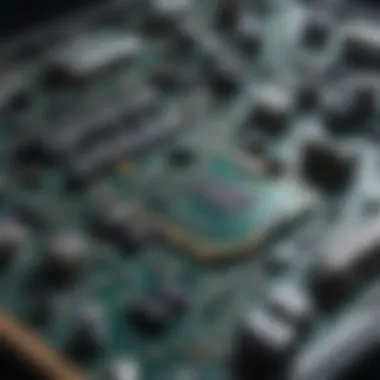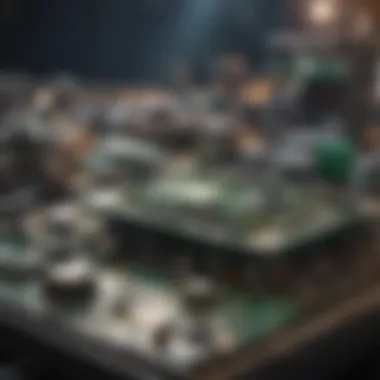Recycling Circuit Boards for Cash: Your Ultimate Guide


Overview of the Topic
Recycling electronic waste has become increasingly relevant in today's world. This is especially true for circuit boards, found in virtually all electronic devices. They are not only integral to functionality but also contain valuable metals such as gold, silver, and copper. These metals can translate into cash through recycling. Understanding the processes and implications of circuit board recycling is critical for both conservationist and those aiming to profit from electronic waste.
In recent years, public interest in sustainable practices has grown. This has led to an awareness of how circuit boards fit into a broader narrative of resource conservation. They can create significant environmental risks if disposed of improperly. While many view waste from electronics simply as garbage, it is far more complex. The components, when properly recycled, contribute to reducing the ecological footprint associated with mining and new production.
Current Status and Challenges
Currently, circuit boards are often underutilized in recycling efforts. Many people remain unaware of the latent value in these materials. The improper disposal leads to toxic e-waste contaminating landfills and waterways. Among the major challenges are the following:
- Improper disposal practices. Many devices are discarded without consideration of their parts.
- Lack of awareness. Consumers do not know the value of recovery.
- Recycling infrastructure. Reliable facilities for e-waste recycling are not available in all areas.
- Cost factors. The processes of dismantling circuit boards can be labor-intensive, leading to high operating costs.
These challenges exacerbate environmental dangers and stall efforts to maximize the utility of precious materials present in used devices. Thus, the need for change in consumer mindset and the infrastructure for recycling circuits is crucial.
Sustainable Solutions
To address these issues, a focus on sustainable practices is imperative. Education plays a key role in informing individuals about the significance of electronic waste recycling. Practical solutions for effective recycling include:
- Selling to specialized recyclers. Some companies provide take-back programs for old devices.
- Community recycling programs. Local events can educate the public and recycle their e-waste efficiently.
- DIY extraction methods. More savvy individuals can learn basic techniques to recover precious metals from circuit boards themselves.
An example of successful recycling practice is the ASUS company implementation of responsible practices in their production line. They encourage users to return old devices, ensuring that the parts are recycled or reused properly. These initiatives can inspire others, showcasing effective management of resources in various locations.
Impact and Importance
The implications of proper circuit board recycling extend beyond immediate financial benefits. They can significantly influence ecosystems, economies, and community health. Here are some impacts to consider:
- Ecosystem protection. Reduced mining allows for the preservation of natural habitats and biodiversity.
- Economic gain. Increased availability of reclaimed materials helps stabilize prices and create job opportunities in recycling sectors.
- Health considerations. Correct disposal can diminish the risk of hazardous materials contaminating the environment.
Ultimately, enforcing a solid waste reduction manifesto will have rewards for future generations. Encouraging recycling is not only beneficial for immediate profit but crucial in cultivating an insightful approach towards resource stewardship and sustainability in community dynamics.
Foreword to Circuit Board Recycling
Recycling circuit boards is a vital practice that often goes unrecognized despite its significant ecological and economic benefits. The importance of understanding and implementing circuit board recycling can not be overstated, especially in a densely digital world. Living in the age of rapid technological advancement, it is only sensible to ask what happens to the devices we discard. This article delves into the intricate components of circuit board recycling, showcasing its benefits, procedures, and relevance in monetary aspects.
Understanding Circuit Boards
A circuit board, or Printed Circuit Board (PCB), serves as the backbone of electronic devices, providing both support and pathways for electrical currents. These boards are made up of various materials, most notably insulators, conductors, and semiconductors. They can be found in a diverse range of electronics, including smartphones, computers, and home appliances. Given their ubiquitous presence, the recycling process of these boards is crucial. Recycling circuit boards captures valuable materials and helps reduce environmental hazards associated with the disposal of electronic waste.
The Need for Recycling
The need for recycling circuit boards stems from several factors influencing our society today. Firstly, the growth in electronic waste is alarming. The numbers of discarded electronics rise each year, not reflecting a similar rate of sustainable recycling practices. According to global statistics, millions of tons of e-waste produced each year go to landfills rather than being recycled. These landfills often release harmful chemicals into the environment.
Additionally, recycling circuit boards presents a hefty opportunity for resource recovery, especially concerning valuable metals such as gold, silver, and palladium. Salvaging these metals reduces dependency on mining, which often entails severe ecological damage.
This recycling not only aids in conserving natural resources but also offers a potential revenue stream for individuals and businesses that choose to engage in these practices.
Exploring the processes involved in recycling circuit boards can reveal both their environmental significance and the financial benefits tied to responsible disposal methods.
Components in Circuit Boards


Circuit boards are intricate assemblies of components that play critical roles in electronic devices. Understanding Components in Circuit Boards is essential when discussing recycling for several reasons. First, knowledge of diverse materials helps in the valuation of recycled items. Second, different components have varying environmental impacts and can contain hazardous substances. Third, some materials have a higher market demand, which impacts profitability in the recycling chain.
Types of Materials Used
Circuit boards are primarily made from several key material types, each serving specific functions. The primary components include:
- FR4 Epoxy: This is the common substrate for circuit boards, composed of glass fiber and resin. It acts as an insulator and provides structural integrity.
- Copper: Essential for conductivity, copper is found in both the pads and traces. Its high scrap value makes it a prime target for recycling.
- Solder: This metal alloy holds components to the board. Common alloys use tin, lead, and silver.
- Gold: Often used in connectors and some ICs (Integrated Circuits) due to its excellent conductivity and resistance to corrosion.
- Plastic: Used in specific components like connectors and casings. While plastic has limited monetary value when recycled, it can offer ecological improvements when shackled from landfills.
The diversity of materials presents unique challenges and opportunities in advanced recycling programs. Each component must be sorted and treated based on its specifications to ensure the least environmental impact while optimizing returns.
Valuable Metals and Their Worth
When talking about recycling circuit boards, the value of metals cannot be understated. Here are some important details regarding valuable metals and their approximate market worth during recent times:
- Gold: With a market price fluctuating around $1,800 per ounce, recycled gold from circuit boards can fetch a significant return.
- Silver: Often valued less than gold at about $24 per ounce, silver is still a notable component found in solder and connections.
- Copper: Currently valued at approximately $4.00 per pound, this is recognized as one of the most lucrative metals to recover during recycling.
- Palladium: At a current value near $2,000 per ounce, palladium is found in some components that utilize catalytic properties.
Recognizing the worth of these materials assists recyclers in strategically planning their extraction processes. Moreover, it's essential to consider that market values might change frequently, creating a need for recyclers to stay informed.
Recycling not only offers potential financial benefits but also contributes aimedly to environmental sustainability. Information on opportunities for profit should be tied closely to understanding the underlying material value.
In summary, the components within circuit boards are varied and significant, offering recyclers numerous paths for operation, monetization, and sustainability.
The Recycling Process
The recycling process is a critical aspect of circuit board recycling, bridging the gap between waste electronics and valuable material recovery. It encompasses several stages, each contributing to the overall efficiency and efficacy of transforming used circuit boards into reusable resources. Effective recycling can reduce the amount of electronic waste entering landfills, alleviate environmental strain, and promote sustainable practices in a resource-constrained world.
Collection Methods
Collecting circuit boards is the first step in the recycling process. Various strategies are employed, often depending on the geographic area and available infrastructure. Common methods include:
- Drop-off Locations: Some local governments and recycling markets establish designated sites for individuals and businesses to deposit unwanted electronics. Depending on the initiative, this method can effectively aggregate material.
- Scheduled Pickup: Companies with larger volumes of e-waste may arrange scheduled pickups, allowing for convenient retrieval of circuit boards directly from the business.
- Retail Take-back Programs: Many electronics retailers have in-store take-back programs, where consumers can return their old devices when purchasing new ones. Such programs significantly increase recycling rates.
The choice of collection method can impact participation rates and overall efficiency. Higher engagement with environmental goals can lead to improved outcomes.
Dismantling Circuit Boards
After collection, the next step involves dismantling the circuit boards. This stage aims to separate valuable parts from less valuable components. Here, efficiency is paramount as dismantling helps prepare the materials for extraction.
Dismantling can either be done manually or with the assistance of machinery. Manual dismantling allows for careful extraction of components like capacitors and resistors, whereas mechanical methods can increase processing speed. Choosing the right approach depends on factors like cost-efficiency and safety considerations.
Extraction Techniques
Extraction techniques are fundamental to unlocking the value embedded in circuit boards. Both mechanical and chemical methods exist, and each has its advantages and disadvantages.
Mechanical Processes
Mechanical processes employ physical methods to recover valuable materials without using harmful chemicals. These can include shredding and crushing to break down component parts into smaller fragments, allowing for easy extraction.
A primary characteristic of mechanical processes is their environmental advantage. By avoiding the use of harsh chemicals, they present a safer option for both workers and the environment. However, the effectiveness of mechanical methods can vary based on the specific materials targeted. The biggest advantage of mechanical processes is their cost-effectiveness, particularly for high-volume operations. On the downside, they may not be as efficient in extracting certain metals compared to chemical processes.
Chemical Processes


Chemical processes involve the use of solvents and various reagents to dissolve specific materials for extraction. These methods are typically more effective at retrieving precious metals, which could otherwise remain uncollected through physical means.
The key characteristic of chemical processes lies in their high specificity; they can selectively target metals like gold, silver, or copper from the scrap. This warrants their popularity in specialized operations where maximizing the yield of particular materials matters most. However, these techniques pose significant challenges. Chemical processes can generate hazardous waste, necessitating proper disposal strategies. Additionally, the costs related to the chemicals and safety measures can be substantial.
Understanding these extraction techniques is vital for achieving responsible recycling of circuit boards, preserving resources, and minimizing ecological impact.
Recognizing the differing methods gives valuable insight into making educated decisions, especially for sustainability-conscious professionals.
Environmental Considerations
Understanding the environmental impact of recycling circuit boards is crucial for anyone looking to engage in this practice. Circuit boards contain various materials, some of which can be harmful to the environment when not disposed of properly. The recycling process can significantly mitigate these impacts while also providing an opportunity for financial gain. Proper handling and recycling ensure that harmful components are treated responsibly, ultimately contributing to a more sustainable future.
Impact on Landfills
Landfills across the globe are increasingly overwhelmed with electronic waste, including circuit boards. When circuit boards end up in landfills, they can take decades or even centuries to decompose. More significantly, these boards often contain heavy metals like lead and cadmium, which can leach into soil and water systems, causing long-term environmental damage.
By recycling circuit boards, the amount of waste in landfills is reduced. Instead of being sent to a landfill, up to 90% of the materials in a circuit board can be recovered and reused. This not only decreases landfill volume but also reduces the need for new raw materials, thereby conserving natural resources.
Toxicity Issues
Circuit boards may comprise several toxic substances that are dangerous to both human health and the environment. For instance, substances like PVC used in insulating materials can release harmful chemicals when burned, and other metals like arsenic can pose serious risks to water supplies if they are leached out.
Responsible recycling techniques address these toxicity issues. Mechanical and chemical processes selectively remove hazardous materials to prevent them from entering the ecosystem. Thus, by properly recycling circuit boards, we not only alleviate the risk associated with landfill overflow but also significantly limit the potential for environmental hazards.
The recycling of circuit boards represents not just an environmental duty but an ethical obligation to our society, ensuring future generations inherit a less polluted planet.
Financial Aspects
Understanding the financial aspects of circuit board recycling is critical for those seeking to navigate this complex but potentially lucrative field. As the demand for sustainable practices grows, recognizing how to maximize gains from recycled materials can significantly influence recycling operations and decisions. The goal is not only to achieve financial profit but also to align economic incentives with environmental responsibility.
Market Value of Recycled Materials
The market value of materials recovered from circuit boards has seen notable increases in recent years. Key metals such as gold, silver, palladium, and copper embedded within these electronic waste items draw both manufacturers and recyclers into a competitive landscape. Identifying the current market prices is essential for determining how much each unit can be resold for, as fluctuations in global commodity markets can directly impact profitability.
Factors influencing the market value include:
- Demand for Electronics: An uptick in electronic manufacturing often drives up the demand for these precious metals.
- Environmental Regulations: With tightening regulations on mining and material extraction, recycled sources become a more attractive option, which can increase market prices.
- Technological Advancements: Innovations in recycling technology improve the efficiency of extracting and refining these valuable materials, potentially increasing yields and profits.
Engaging with bulletin boards or platforms like Reddit can be useful for gauging current trends and participating in discussions with other recyclers about market values. These interactions may provide insights into how to justify the investments made in recycling processes and determine the best timing for selling reclaimed materials.
Profitability Analysis
A comprehensive profitability analysis involves evaluating the costs and revenues associated with circuit board recycling operations. Factors contributing to these calculations may include:
- Initial Investment: This encapsulates the cost of equipment, labor, and facilities needed to undertake recycling processes properly.
- Operational Costs: These include ongoing expenses such as utilities, waste disposal, and maintenance of plants involved in the recycling.
- Material Sales Revenue: Calculating anticipated revenue from the sale of recovered materials is crucial. Market assessments can help forecast potential profits.
- Environmental and Regulatory Costs: Staying compliant with various environmental laws often has expense implications but also potential benefits through grants or subsidies for sustainable practices.
Profitability can be achieved if one strikes the right balance between streamlining processes and leveraging the market effectively. A good investment in dismantling and extracting systems can provide quicker returns. Moreover, refining relationships across the supply chain improves negotiation power and long-term gains. Businesses may also seek partnerships or technological alliances that can enhance operational efficiency and profitability.
Regularly reviewing financial reports enables organizations to adjust practices and seize opportunities within a shifting market. Leveraging correct inputs ensures longer-term trajectories allow greater investment in innovation, leading to improved sustainability and profit margins.


Regulatory Framework
The regulatory framework surrounding circuit board recycling plays a crucial role in ensuring that the process is both safe and effective. Compliance with environmental laws and adherence to industry standards are integral aspects that ensure the protection of human health and the environment while facilitating the profitable management of electronic waste. This framework informs operators about legal requirements, best practices, and potential liabilities associated with electronic waste management. Understanding these regulations can significantly impact the short and long-term viability of one's recycling operations.
Compliance with Environmental Laws
Complying with environmental laws is essential for any circuit board recycling endeavor. These laws regulate how electronic waste should be processed, stored, and disposed of, reducing harmful impacts on our ecosystems. National legislation like the Resource Conservation and Recovery Act (RCRA) in the United States mandates safe disposal practices and encourages waste minimization through recycling.
Failure to comply with these regulations could lead to severe penalties, including fines and operational shutdowns. Keeping informed about changes in legislation also allows recyclers to maintain compliance while capitalizing on potential advantages tailored to sustainable practices. This could lead to tax incentives, grants for developing innovative practices, or even improved market opportunities. Crucially, adherence not only signifies commitment to environmental stewardship but also engenders trust with consumers and stakeholders.
Ultimately, legal compliance not only protects the environment but also smartens the profitability of the recycling business.
Industry Standards
Industry standards form another critical layer in the landscape of circuit board recycling. They provide guidelines that go beyond law compliance, focusing on optimizing the recycling process for efficiency and environmental protection. Standards such as the International Organization for Standardization (ISO) provides frameworks that organizations can utilize to streamline their operations while enhancing performance measures.
Adopting industry standards promotes safety, which is a critical consideration during the extraction of metals and dismantling processes due to the potential release of hazardous materials. Establishing comprehensive safety protocols based on these standards assists in preventing worker exposure to toxic substances often found in electronic waste. The implementation of standards also positions companies to engage in international trade, broadening market access for recycled materials.
Understanding and adhering to industry standards can enhance brand reputation, drive quality enhancements, and enable thorough documentation practices, essential for audits and certification applications. This foundational knowledge remains vital for preserving the interests of businesses involved in electronic waste recycling and aligns their efforts with broader environmental goals.
Future of Circuit Board Recycling
The topic of circuit board recycling holds vital significance in today’s strained ecosystem. As technology continues to evolve, becoming increasingly embedded in daily life, the rate of electronic waste is rising substantially. This accumulation not only poses a threat to the environment but also presents an economic opportunity. Recycling circuit boards has the potential to recover valuable resources and reduce landfill waste, thus creating a twofold benefit of both economic gain and environmental protection.
Advancements in Recycling Technology
Technological progress plays a crucial role in improving the efficiency and effectiveness of circuit board recycling. Recent advancements allow for more precise recovery methods that reduce environmental harm. For example, innovations in automated dismantling methods offer faster processing times while preserving components' integrity. Some flooding spaces even integrate artificial intelligence to identify valuable metals within obselete devices.
Further expanse into the realm of hydrometallurgical techniques has streamlined the extraction process of precious metals like gold and copper. These technologies enhance recovery rates and eliminate the negative impact commonly associated with traditional shredding methods. By utilizing more sophisticated approaches, recyclers can increase profitability and minimize waste.
Such advancements pave way for industry leaders to operate on a greener scale with better opportunities for generating revenue. Developing waste-to-energy frameworks adds another layer to the tech advancements transforming traditional recycling into a sustainable model with lasting impact.
Sustainability Trends
As consumer awareness surrounding sustainability grows, there is a substantial increase in emphasis on eco conscientious practices in the electronics industry. Assessing sustainability trends reveals a push toward responsible sourcing of materials along with ethical recycling practices. Enterprises are now actively looking to align with people and legislations pushing for improved waste management.
Such trends include:
- Designing for Disassembly: Engineers are opting to design products that facilitate easy disassembly for future recycling, ensuring components are recoverable.
- Circular Economy Models: Companies are embracing circular economy principles, which focus on reusing and recycling materials instead of throwing them away.
- Consumer Consciousness: Customers are becoming more informed about the environmental impacts of waste. They increasingly seek products from sustainable sources and support brands committed to responsible end-of-life strategies.
All these elements show how circuit board recycling is evolving. Companies are beginning to acknowledge that eco-friendly practices do not solely serve societal welfare but also serve their financial interests.
The End
The importance of recycling circuit boards extends beyond monetary gain. This practice addresses multiple critical areas such as environmental sustainability, resource management, and contributing to an efficient circular economy. Recycling these boards not only recovers valuable materials but also promotes responsible disposal of electronic waste. Moreover, understanding these elements can inspire action and raise awareness among conservationists and environmentalists.
Summary of Key Points
In summary, several key points arise from the discussion on circuit board recycling:
- Value Recovery: Valuable metals like gold, silver, and copper can be extracted, providing a financial incentive.
- Environmental Impact: Reducing landfill waste and toxic leaching is crucial for ecological health.
- Regulatory Awareness: Firms need to comply with relevant laws and standards governing the recycling industry.
- Technological Advancements: Emerging techniques improve recycling efficiency and effectiveness, paving the way for more sustainable practices.
- Consumer Responsibility: As individuals, being mindful of e-waste disposal can lead to significant change.
Call to Action
In light of the aforementioned aspects, an immediate call to action emerges for all citizens, students, and professionals. Advocate for and engage in circuit board recycling initiatives within your community. Whether you are an individual with old electronics or work within an organization, make informed decisions regarding the recycling of such materials. By supporting local recycling programs or learning more about eco-friendly technologies, you can directly contribute towards a healthier planet and a thriving circular economy.
Join the environmental movement today by recycling your circuit boards responsibly. Knowledge is power; the first step towards sustainability starts with you.



